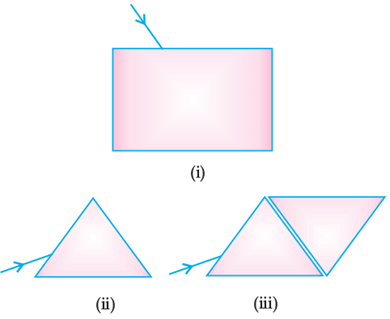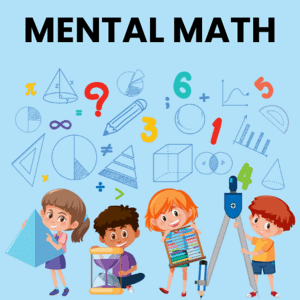Class 10 Science Chapter 9 Case Based Questions - Light Reflection and Refraction
Study the given diagram and answer the questions.
A very thin narrow beam of white light is made incident on three glass objects shown below. Study the nature and behaviour of the emergent beam in all the three cases. Question 1:
Question 1:
Following are the possibility of two emergent beams being similar. Choose the correct answer:
(a) (i) and (ii)
(b) (i) and (iii)
(c) (ii) and (iii)
(d) No similar emergent beams
Correct Answer is Option (b)
In rectangular glass slab the ray undergoes only refraction and emerges out parallel. In a prism the emerging ray is not parallel but split due to change in wavelength of different colour of light. The shape of the glass slab with two prisms up and down splits light but recombines it into one.
Question 2:
The light changes its path as its medium changes. Which of the following is incorrect statement.
(a) Speed of light is different in different media.
(b) Light changes its path because light only travels in straight line.
(c) Speed of light is dependent on medium through which it is passing.
(d) The light chooses the path with minimum time, as it changes its medium.
Correct Answer is Option (b)
Light changes its path because light only travels in straight line.
Question 3:
Light travel fastest in:
(a) Air
(b) Vacuum
(c) Glass
(d) diamond
Correct Answer is Option (b)
Light travels faster in vacuum than any other medium. This is because there is no obstruction in vacuum for the propagation of light and thus, the refractive index of vacuum is the lowest.
An object is kept at a distance of 18 cm, 20 cm, 22 cm and 30 cm, from a lens of power + 5D.
Question 4:
The focal length of the given lens is:
(a) 0.2 cm
(b) 20 cm
(c) 5cm
(d) 0.5 cm
Correct Answer is Option (b)
P = 1/f, f = 100/5 = 20 cm
Question 5:
In which case or cases would you get a magnified image?
(a) 18cm
(b) 20cm
(c) 22cm
(d) All the above
Correct Answer is Option (d)
An object at 18 cm, 22 cm, and 30 cm, the image can be magnified.
Question 6:
The power of a lens of focal length 1 metre is called as:
(a) Refractive index
(b) 1 dioptre
(c) Speed of light
(d) Wavelength
Correct Answer is Option (b)
The power of a lens whose focal length is one metre is dioptre.
Question 7:
Name the lens/mirror used in film projectors and telescopes:
(a) Convex lens
(b) Concave lens
(c) Convex mirror
(d) Concave mirror
Correct Answer is Option (a)
Convex lens used in film projectors and telescopes, where the distance between the eye's lens and retina is too short, as a result of which the focal point lies behind the retina. Eyeglasses with convex lenses increase refraction, and accordingly reduce the focal length.
Question 8:
Which of the magnified image can we get on a screen?
(a) At 18 cm
(b) At 18 cm and 22 cm
(c) At 20 cm and 22 cm
(d) At 22 and 30 cm
Correct Answer is Option (d)
At 22 cm and 30 cm, image can be obtained on a screen.
FAQs on Class 10 Science Chapter 9 Case Based Questions - Light Reflection and Refraction
| 1. What is light reflection? |  |
| 2. What is light refraction? |  |
| 3. How does reflection of light occur? |  |
| 4. What are the laws of reflection? |  |
| 5. How does refraction of light occur? |  |




















